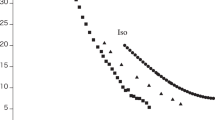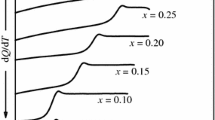Abstract
In this study, the thermal behavior of butanediol isomers is investigated for temperatures ranging from 103 to 303 K using differential scanning calorimetry, complemented, when necessary, by polarized light thermal microscopy. The butanediol isomers display quite different thermal behaviors: for 1,2- and 1,3-isomers, glass transition is the only thermal event observed; for 1,4-butanediol, crystallization occurs on cooling even at a high scanning rate and no glass formation was detected; and for the 2,3-isomer, glass or crystal formation is dependent on the experimental conditions employed. The glass-forming ability of the isomers is correlated with data available on their molecular symmetry.







Similar content being viewed by others
References
Gräfje H, Körnig W, Weitz HM, Reiß W, Steffan G, Diehl H, et al. Butanediols, Butenediol, and Butynediol. In: Bailey JE, Brinker CJ, Cornils B, editors. Ullmann’s Encyclopedia of Industrial Chemistry (electronic release). 7th ed. Wiley-VCH: Weinheim; 2000.
Boutron P, Mehl P, Kaufmann A, Angibaud P. Glass-forming tendency and stability of the amorphous state in the aqueous solutions of linear polyalcohols with four carbons: I. Binary systems water-polyalcohol. Cryobiology. 1986;23:453–69.
Mehl P, Boutron P. Glass-forming tendency and stability of the amorphous state in the aqueous solutions of linear polyalcohols with four carbons: II. Ternary systems with water, 1, 2-propanediol or 1, 3-butanediol or 2, 3-butanediol. Cryobiology. 1987;24:355–67.
Boutron P. Levo- and dextro-2, 3-Butanediol and their racemic mixture: very efficient solutes for vitrification. Cryobiology. 1990;27:55–69.
Boutron P. Cryoprotection of red blood cells by a 2, 3-butanediol containing mainly the levo and dextro isomers. Cryobiology. 1992;29:347–58.
Boutron P, Mehl P. Theoretical prediction of devitrification tendency: Determination of critical warming rates without using finite expansions. Cryobiology. 1990;27:359–77.
Sutton RL. Critical cooling rates to avoid ice crystallization in solutions of cryoprotective agents. J Chem Soc Faraday Trans. 1991;87:101–5.
Boutron P. Glass-forming tendency and stability of the amorphous state in solutions of a 2, 3-butanediol containing mainly the levo and dextro isomers in water buffer and Euro-Collins. Cryobiology. 1993;30:86–97.
Chirico RD, Knipmeyer SE, Steele WV. Heat capacities, enthalpy increments, and derived thermodynamic functions for benzophenone between the temperatures 5 K and 440 K. J Chem Thermodyn. 2002;34:1885–95.
Sabbah R, Xu-Wu A, Chickos JS, Leitão MLP, Roux MV, Torres LA. Reference materials for calorimetry and differential thermal analysis. Thermochim Acta. 1999;331:93–204.
Drake PW, Dill JF, Mumtrose CJ, Meister R. A study of viscoelastic properties of butanediol-1, 3 using optical digital correlation spectroscopy. J Chem Phys. 1977;67:1969–77.
Mullin JW. Crystallization. 3rd ed. Oxford: Butterworth Heinemann; 1993.
Tamman G. States of Aggregation. New York: van Nostrand; 1925.
Kauzmann W. The nature of the glassy state and the behavior of liquids at low temperatures. Chem Rev. 1948;43:219–56.
Kanno H. A simple derivation of the empirical rule: T G/T M = 2/3. J Non-Cryst Solids. 1981;44:409–13.
Dudowicz J, Freed KJ, Douglas JF. The glass transition temperature of polymer melts. J Phys Chem B. 2005;109:21285–92.
Wang LM, Angell CA, Richert R. Fragility and thermodynamics in nonpolymeric glass-forming liquids. J Chem Phys. 2006;125:74505.
Zábranský M, Růžička V Jr. Estimation of the heat capacities of organic liquids as a function of temperature using group additivity: an amendment. J Phys Chem Ref Data. 2004;33:1071–81.
Origin. Scientific Graphing and Analysis Software. Version 7. Northampton: OriginLab Corporation; 2002.
Nunes SCC, Eusébio ME, Leitão MLP, Redinha JS. Polymorphism of pindolol, 1-(1H-indol-4-yloxyl)-3-isopropylamino-propan-2-ol. Int J Pharm. 2004;285:13–21.
Takeda K, Yamamuro O, Tsukushi I, Matsuo T, Suga H. Calorimetric study of ethylene glycol and 1, 3-propanediol: configurational entropy in supercooled polyalcohols. J Mol Struct. 1999;479:227–35.
Takeda K, Murata K, Yamashita S. Thermodynamic investigation of glass transition in binary polyalcohols. J Non-Cryst Solids. 1998;213:273–9.
Angell CA, Smith DL. Test of the entropy basis of the Vogel-Tammann-Fulcher equation. Dielectric relaxation of polyalcohols near Tg. J Phys Chem. 1982;86:3845–52.
Gao C, Zhou GY, Xu Y, Hua TC. Glass transition and enthalpy relaxation of ethylene glycol and its aqueous solution. Thermochim Acta. 2005;435:38–43.
Jabrane S, Létoffé JM, Claudy P. Study of the thermal behaviour of 1, 3-propanediol and its aqueous solutions. Thermochim Acta. 1998;311:121–7.
Birge NO. Specific-heat spectroscopy of glycerol and propylene glycol near the glass transition. Phys Rev B. 1986;34:1631–42.
Jabrane S, Létoffé JM, Claudy P. Vitrification and crystallization in the R(−)1, 2-propanediol-S(+)1, 2-propanediol system. Thermochim Acta. 1995;258:33–47.
Eusébio ME, Jesus AJL, Cruz MSC, Leitão MLP, Redinha JS. Enthalpy of vaporisation of butanediol isomers. J Chem Thermodyn. 2003;35:123–9.
Jesus AJL, Rosado MTS, Leitão MLP, Redinha JS. Molecular structure of butanediol isomers in gas and liquid states: combination of DFT calculations and infrared spectroscopy studies. J Phys Chem A. 2003;107:3891–7.
Tanaka H. Relationship among glass-forming ability, fragility, and short-range bond ordering of liquids. J Non-Cryst Solids. 2005;351:678–90.
Shintani H, Tanaka H. Frustration on the way to crystallization in glass. Nat Phys. 2006;2:200–6.
Debenedetti PB. Metastable Liquids, Concepts and Principles. New Jersey: Princeton University Press; 1996.
Reva ID, Jesus AJL, Rosado MTS, Fausto R, Eusébio ME, Redinha JS. Stepwise conformational cooling towards a single isomeric state in the four internal rotors system 1, 2-butanediol. Phys Chem Chem Phys. 2006;8:5339–49.
MTS Rosado, AJL Jesus, I Reva, JS Redinha (manuscript in preparation).
Jesus AJL, Rosado MTS, Reva I, Fausto R, Eusébio ME, Redinha JS. Conformational study of monomeric 2, 3-butanediols by matrix-isolation infrared spectroscopy and DFT calculations. J Phys Chem A. 2006;110:4169–79.
Jesus AJL, Rosado MTS, Reva I, Fausto R, Eusébio ME, Redinha JS. Structure of isolated 1, 4-butanediol: Combination of MP2 calculations, NBO analysis, and matrix-isolation infrared spectroscopy. J Phys Chem A. 2008;112:4669–78.
Author information
Authors and Affiliations
Corresponding author
Rights and permissions
About this article
Cite this article
Maria, T.M.R., Lopes Jesus, A.J. & Eusébio, M.E.S. Glass-forming ability of butanediol isomers. J Therm Anal Calorim 100, 385–390 (2010). https://doi.org/10.1007/s10973-009-0633-z
Received:
Accepted:
Published:
Issue Date:
DOI: https://doi.org/10.1007/s10973-009-0633-z




